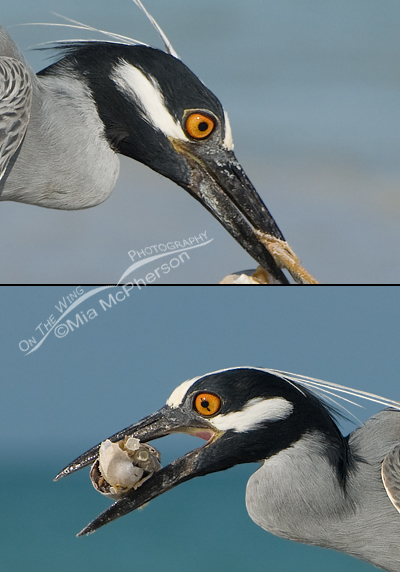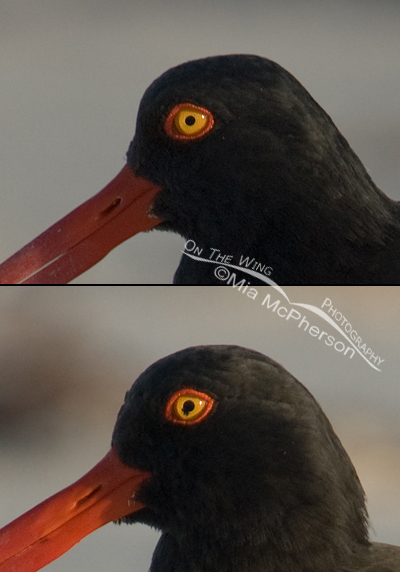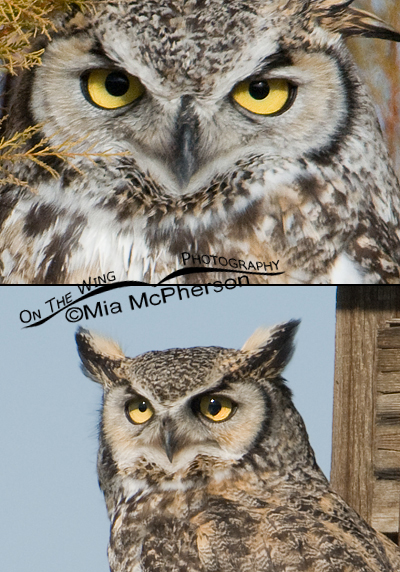Blown Eyes
 Yellow-crowned Night Heron (Nyctanassa violacea) composite with blown eye
Yellow-crowned Night Heron (Nyctanassa violacea) composite with blown eye
Because I am a bird photographer I get to see and photograph our beautiful feathered friends, learn their habits and behaviors and sometimes I get to take a look at unusual conditions in the birds themselves.
The Yellow-crowned Night Heron above exhibits what I and other bird photographers have come to call “blown eye”. Both of the images are photos of the same bird and the right eye frame at the top is normal. The second image shows two tear drop shaped black blobs in the iris which is abnormal. I don’t know if this was caused by an injury or if this might be a congenital condition.
 American Oystercatcher (Haematopus palliatus) composite with blown eye
American Oystercatcher (Haematopus palliatus) composite with blown eye
While I lived in Florida I often noticed “blown eyes” in American Oystercatchers and I have seen it where it was evident in both eyes of adult birds. The juvenile Oystercatchers have dark irises and it might be difficult to detect if their eyes are “blown” without getting images that are lit well and close up. These images are of two different birds that were a mated pair.
I recently read about a congenital condition in humans called “iris colobomas” which is also found in other mammals and birds and have begun to wonder if that might not be the cause of the abnormal pupils I see in some species of birds instead of an injury to the eye.
 Great Horned Owl (Bubo virginianus) composite with blown eye
Great Horned Owl (Bubo virginianus) composite with blown eye
The top Great Horned Owl (photographed in Utah) in the composite above has normal eyes, the difference in the size of the pupils is caused by the angle of light dilating the pupils differently. The Great Horned Owl (photographed in Montana) shows a left “blown” eye. To me it looks like the pupil has leaked into the iris.
I’ve seen this condition in the species I have shown in my images and I’ve also seen it occur in Bald Eagles.
None of the birds I have photographed with blown eyes appear to have any difficulty seeing and it doesn’t seem to limit their ability to stalk or hunt prey. The Yellow-crowned Night Heron in the image above stalked, captured and ate three Ghost Crabs while I observed and photographed it. American Oystercatchers probe for their prey and none of the birds with blown eye that I observed exhibited any more difficulty in locating food than the adults nearby that did not have this condition. The Great Horned Owl with the blown eye was a male and the pair had three chicks and I am almost certain he had no difficulties providing food for them.
I wonder how many other bird species exhibit “blown eyes” and what the cause is. Injury or Congenital Defect. I would love to read additional input on this topic so please feel free to comment.
Life is good.
Mia
Click here to see more of my bird photos.





Thanks for the post Mia. I always learn something interesting.
Not sure if you’ll even see this comment (I’m only more than a year late), but the dark flecks within the irides of oystercatchers is found to be a sex-linked trait…at least in Black Oystercatchers (which are very closely related), the presence of large, dark eye fleck is a strong indicator of the bird being a female. The cause is still unknown, however, although it seems unlikely that most female oystercatchers are going around with impaired vision.
Hi Mia
Interesting phenomenon. I’d never noticed it until I read this blog post a week or so ago. I photographed a white-eyed vireo in Volusia Co., FL, this morning that has what appears to be a blown eye. You can see a photo here
Holy shit. I had no idea the link was that huge. Hope it works. (I shortened the link for you)
The blown eye was the left; the right appeared normal.
Hi Peter,
That looks to be a blown eye in the Vireo image. I hadn’t seen it in a warbler/passerine before. This is very interesting. I hope we all find some answers to this.
Mia:
I’m glad you posted this and I enjoyed seeing your new photos, reading your remarks and the comments made by others.
Did you happen to save any of the messages from our earlier exchanges? As you know my gmail account was hijacked and I lost the messages that contained the references to the papers I found that are pertinent. I’m sure I could find them again, but if you saved any of the messages, would you forward them to me.
Thanks,
Dave
David, I searched through our emails and found several I will forward to you concerning the discussions we had on blown eyes before. Thank you for commenting!
I don’t know how I missed this post. It’s really interesting, and the many comments shed some light on the condition. All-in-all, and interesting discussion. Nice photos too!
Thanks Linda. I’ve really enjoyed this discussion on blown eyes and have learned more about it too.
Very interesting discussion. Your photos and the subsequent information provided by you and others is a real contribution to enhancing our awareness of this condition. This is a great topic for the Focusing on Wildlife forum as well.
Thanks Julie, it is an interesting topic!
You have to have a lot of captures to be able to see this many abnormalities. I found it really interesting to read your article Mia, thanks for sharing.
Vinnie
Thanks for commenting on this Vincent. I found the Bald Eagle shots with the blown eye but too late to place in this post.
Hi Mia,
I recently saw a very similar defect in a wild Amur tiger that had taken to preying on domestic animals. I sent photos to a colleague who is a wildlife veterinarian and here is a paraphrase of his response:
‘… the strange tear-drop shaped irises are a defect known as “colobomata” – developmental defects arising during fetal life. In domestic cats, colobomata are not thought to be genetic in origin – rather they are described as being spontaneous. These defects may affect the animal’s vision by reducing accurate control of the iris in adapting to different light levels and clear focusing could also be compromised.’
So, it looks like you were on track in your research.
I would add that such defects could be caused by many things including infectious disease, contaminants, or trauma.
Many state wildlife agencies have wildlife pathologists (Wyoming, for example, does allot of pathology work) and that would be a good place to look for more information.
Cheers,
John Goodrich
http://www.zenfolio.com/tiger372
PS. Love your photos!
Hi John,
Thanks for visiting and for the information you provided on the Tiger and for sharing what your colleague said about this condition in cats.
I looked at your site yesterday, you have some wonderful images and the ones of the Tigers and birds from Russia are fascinating.
I’ve also never seen this phenomenon. I will look more closely at any vivid eye photos I have, from now on.
Thanks for commenting Ingrid!
A very interesting post Mia and something I have never seen before.
Steve, if you do get images of birds with blown eyes I would like to see them!
Very interesting! I noticed it with Oystercatchers, I think on one owl, and I’m pretty sure I have images of a Bald Eagle with a “blown eye.”
Hi Heather, thanks for commenting on this post.
Very interesting observations and information. Your photos provide great documentation of these eye abnormalities.
Thanks Tammy! I hope to find out if there are congential defects in certain bird species that cause the iris malformations.
Wonderful photos Mia. Interesting, I know horses have something like this but they all have it where these seem only some have. Something to strive to see more of.
Dan, thanks so much for commenting. I’ve gotten to the point where I look at the eyes of my subjects closely after I get the files uploaded to my pc to look for abnormalities.
Thanks for the posting, Mia. Something I’d not heard about, but will now be looking for when I’m lucky enough to get that detailed of an image of a bird’s eye.
If it just a (congenital?) malformation of the iris, I conjecture that wouldn’t affect vision too much as the iris is used like the aperture diaphragm in a camera lens, i.e., it doesn’t affect focus, only the about of light falling on the sensor (retina.) The bird could adapt to this without it affecting hunting or food gathering, as you’d observed.
An injury that affects the cornea or lens would be a totally different issue.
Bill, thanks for commenting on this post. I suspect that some of the iris malformations I have seen are a result of injury but I think some of the others may be congenital defects. I would think the congenital defects probably don’t affect the vision of the bird too much.
Research has been done regarding eye damage in owls. It is indeed an injury that occurs.
Journal of Raptor Research 42(4):243-247. 2008
doi: http://dx.doi.org/10.3356/JRR-07-42.1
Eye Injuries in Long-eared Owls (Asio otus): Prevalence and Survival
LESIONES OCULARES EN ASIO OTUS: PREVALENCIA Y SUPERVIVENCIA
Denver W. Holt and Elizabeth A. Layne
Owl Research Institute, P.O. Box 39, Charlo, MT 59824 U.S.A.
Creekside Veterinary Hospital, Bozeman, MT 59718 U.S.A.
Email address: owlmontana@charlo.net
Abstract
Thirty-eight eye injuries and abnormalities were noted over a 22-yr period studying Long-eared Owls (Asio otus). Injury frequency, distribution per eye, shape, size, and directionality, are reported. The prevalence rate was low (2.05%), as only 31 of 1510 owls had noticeable injuries to the iris. Seven other noticeable eye abnormalities are also described. There was no significant difference between the number of injuries in the left versus right eye; however, there were significantly more injuries in the bottom half of the eye verses the top, suggesting some directionality. Nine of the owls with iris injuries were recaptured between 2 wk and 3 yr later, with four of the nine recaptured 1–3 yr later. Two owls with noticeable eye abnormalities were recaptured 2 mo and 4 mo later. This suggests the ability of some individuals to survive with ocular trauma.
Thanks for your comment Kylie and the information you provided. With the owl that my friend Kathy mentioned the sudden onset of its pupil/eye issue does indicate trauma of some sort. Earlier I had presumed that these ocular abberations were all the result of injuries the birds had sustained.
When I looked up “iris colobomas” I found images of people that have the same type of iris/pupil apperances and found a study on Colobomas of the iris in a flock of rosecomb bantam chickens which caused me to wonder if some of the eye problems I have seen and photographed might not be congenital. I appreciate your comment on this very much.
——————————–
Avian Dis. 2004 Sep;48(3):686-90.
Colobomas of the iris in a flock of rosecomb bantam chickens.
Cardona CJ, Plumer K.
Source
Department of Population Health and Reproduction, University of California, Davis, Davis, CA 95616, USA.
Abstract
A defect in the pupil shape ofrosecomb bantam chickens was noticed by a breeder. The pupil in affected birds appeared to be elongated at the lower margin and consistent with a coloboma of the iris. Upon examination of all birds in the flock, the defect was found in 26% of females and 9% of males. Examination of breeders older than 1 yr led to the discovery ofcolobomas, although there were not enough birds to accurately determine the prevalence of the problem for previous generations. Affected birds were examined for other lesions, and none were found. Specific-pathogen-free (SPF) eggs were incubated and hatched with eggs from the affected flock as sentinels. No SPF chicks developed colobomas of the iris, while 37% of the bantams in the same hatch were affected. This experiment eliminated many possible infectious agents and incubator or brooder malfunction as causes of this eye lesion. An analysis of the flock pedigree suggested that the defect might be inherited and might be related either to feather color or to gender. No statistically significant correlation could be made between feather color and the iris colobomas. However, the trait was twice as likely to occur in females as in males, which suggests that it is a sex-influenced trait. Based on the determination that this was an inherited trait, a breeding strategy to reduce the prevalence of the lesion in which affected birds were removed from the breeding flock was developed and followed for 2 yr. The prevalence of colobomas was 22% in females and 2.9% in males after the first year and 7.8% and 0.8% in females and males, respectively, after the second year.
PMID: 15529996 [PubMed – indexed for MEDLINE]
Stunning images Mia. I love the Yellow-Crowned Night Herons. I wonder too is the loss of sight in the eye leads the birds to develop strengthened hearing and such, as it often does with blind people.
Laurence, It would be interesting to know if the loss of sight in a bird strengthens its other senses. I imagine the loss of sight in both eyes might be fatal for a bird in the wild.
Mia – A female nesting GHO at Ft. DeSoto just had an eye injury of some type wherein here entire eye is now very dark. I hoping that, together with her mate, they can raise their young owlet with no problems.
Kathy, I’m sorry to hear the the female sustained some type of eye injury and I hope that she and her mate will be able to successfully raise their brood. I seem to recall that two years ago the male GHOW on Honeymoon Island State Park sustained an eye injury and was captured, rehabilitated and released back to the island and that during that breeding season there were no chicks hatched.
I hope this discussion continues on blown eyes.